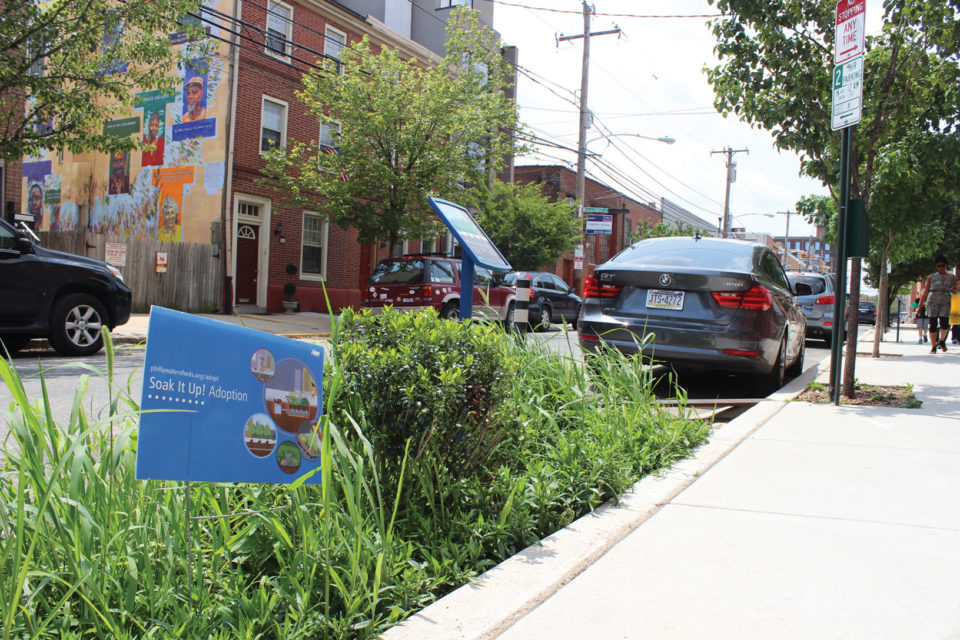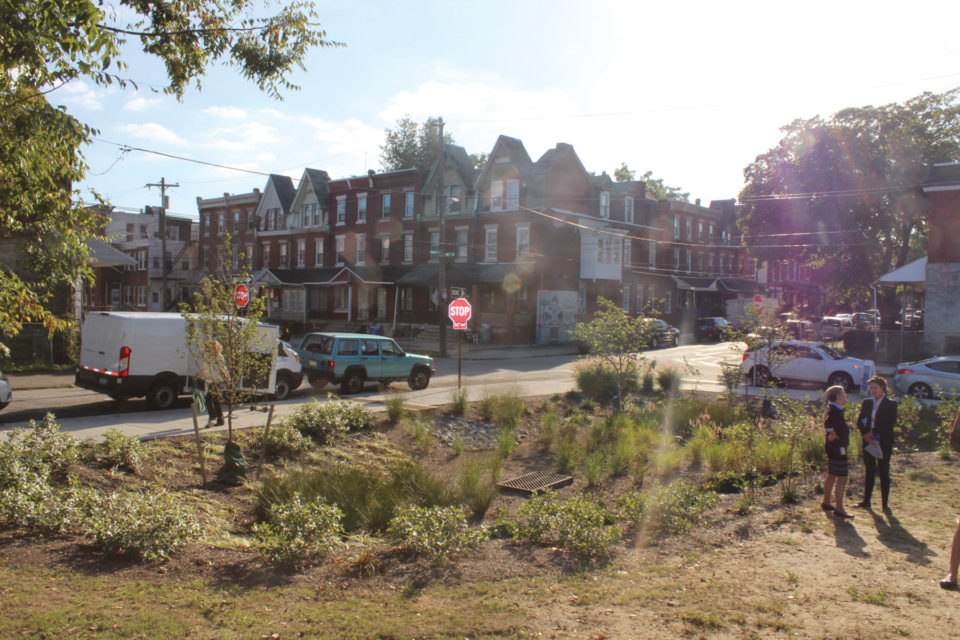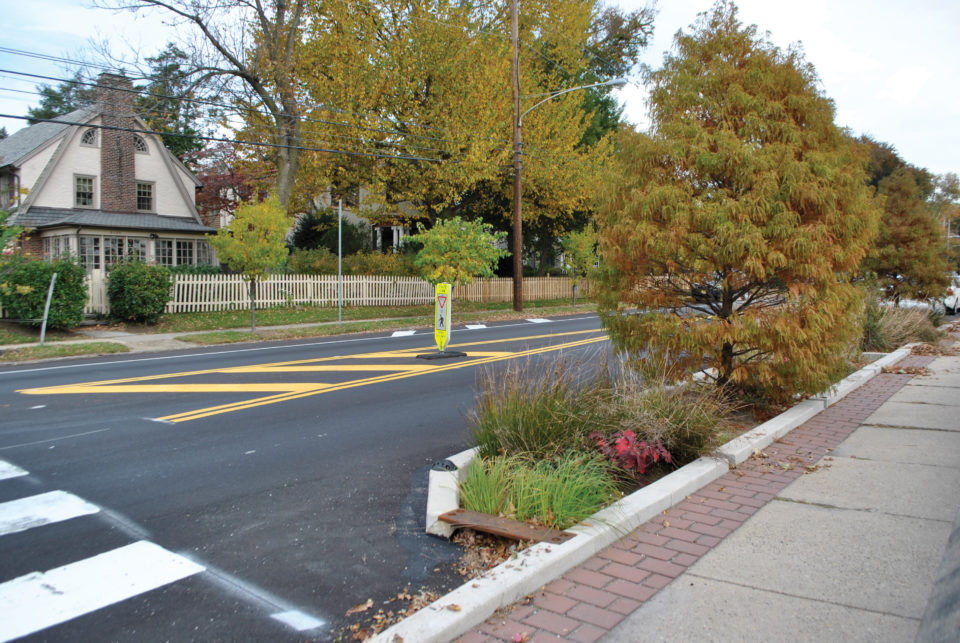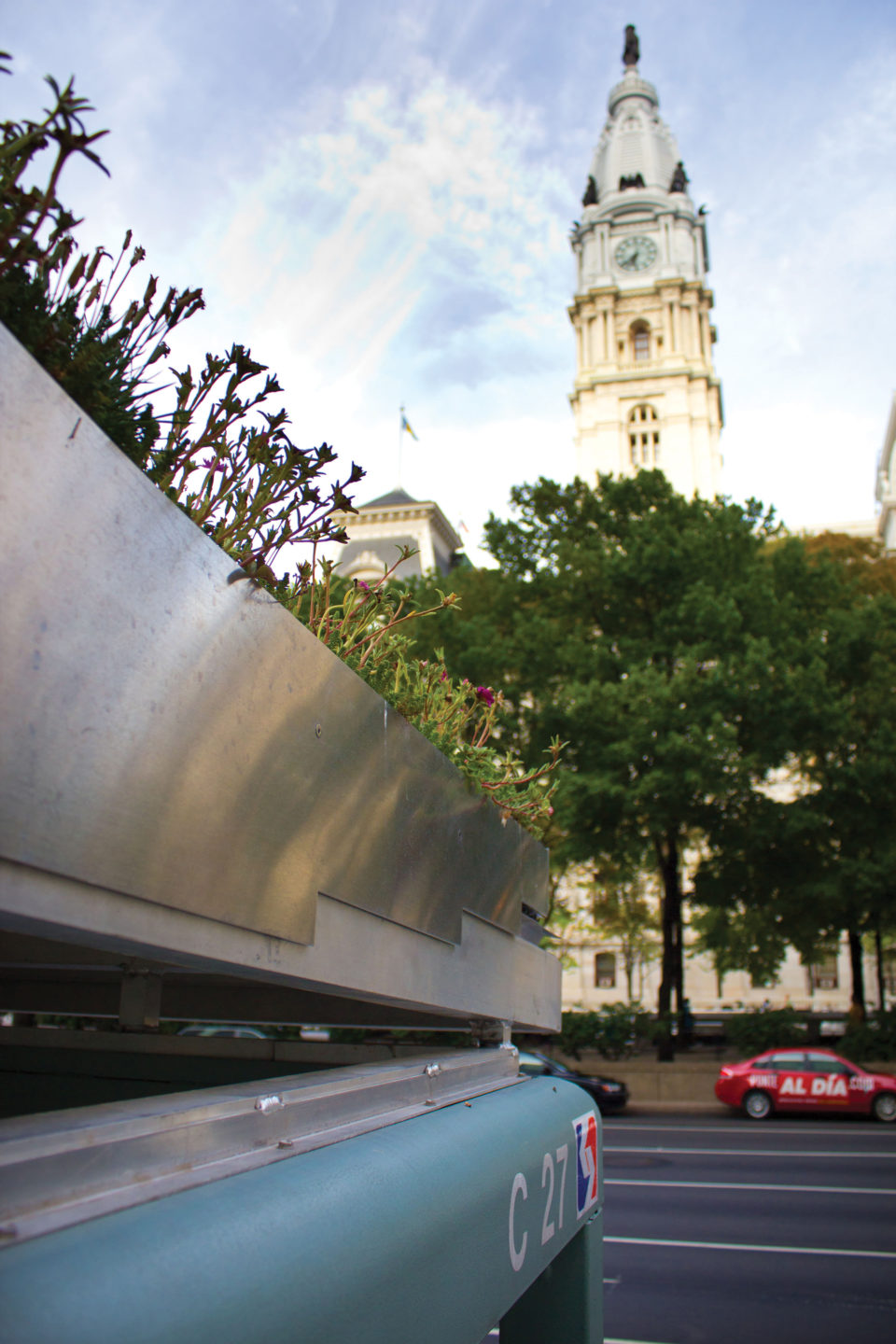
Credit: Philadelphia Water Department
Project Area: CSO-based
Impervious Area Within Combined Sewer System: 28,692 acres
Participating Agencies: Philadelphia Water Department, Department of Streets, PennDOT, Southeastern Pennsylvania Transportation Authority, Commerce, Philadelphia Planning Commission
Timeline: Green City, Clean Waters plan was published in 2009
Implementation began in June 2011
In the first five years of the program, 111 Green Streets were constructed
Cost: $2.4 billion over 25 years
GOALS

Credit: Philadelphia Water Department
Stormwater management: Reduce combined sewer overflow pollution by 85% and achieve water quality improvements in compliance with state and federal mandates.
Cost-effective regulatory compliance: Reduce combined sewer overflow events using green infrastructure to save billions of dollars in gray infrastructure investment needs.
Water quality: Improve water quality in Philadelphia’s rivers and watersheds.
Overview
The Philadelphia Water Department (PWD) is required under a 2011 Consent Order and Agreement administered by the Pennsylvania Department of Environmental Protection to reduce combined sewer overflows and improve water quality within the city of Philadelphia. The City of Philadelphia’s landmark plan to meet its goals associated with the Consent Agreement, Green City Clean Waters (GCCW), prioritizes the deployment of green infrastructure across the City of Philadelphia utilizing PWD investments, regulatory and stormwater fee modifications, and grants to manage the first inch of stormwater from over 9,500 acres of impervious surface. GCCW’s GSI investments are more cost effective than traditional gray stormwater investments, and enable the department to support investments across Philadelphia that support improvements to the City’s parks, schools, and streets.
Streets represent approximately 38% of all impervious surfaces within the CSO, close to twice the second highest category of impervious surface within the CSO (residential rooftops which represent 20% of impervious surfaces within the CSO). PWD’s Green Streets program utilizes the City’s authority over the ROW, and ongoing multi-agency investments there-in to deploy an ambitious portfolio of green infrastructure investments across Philadelphia’s streets.
Philadelphia’s green stormwater infrastructure investments are each designed to maximize the amount of stormwater managed at a given location. A variety of interventions, from bioswales to rain gardens, vegetated bumpouts and tree trenches are built along the ROW to capture runoff from streets and sidewalks. Aided by a Green Street Design Manual that makes the City’s design standards available to consultants, engineers, and partners, PWD has been able to build projects with agency partners from PennDOT to SEPTA.
PWD’s partnerships have supported other City investments. Collaborating on Safe Routes to Schools projects, Philadelphia’s Water Department has been able to green bumpouts in support of reduced crossing distances near schools, increase the City’s tree canopy, and invest in greening commercial corridors.
KEYS TO SUCCESS

Credit: Philadelphia Water Department
Points of contact: Establishing Green Infrastructure liaisons in partner agency planning and engineering departments has been particularly helpful in facilitating the identification and creation of new Green Street partnership opportunities and resolving inter-agency conflicts and concerns.
Ongoing and regular communication: The creation of a Green Street Committee that meets on a quarterly basis with the Streets Department provides an open forum to explore new designs and resolve project management concerns. The Green Streets Committee is tasked with reviewing and approving pilot technologies, managing concerns related to IT and GIS systems, improving agency protocols, and discussing partnership projects.
Preview protocols: Because each Green Street in Philadelphia is designed to maximize the amount of stormwater managed at a given location, the City’s Green Street program requires its partners to provide input early, and often. Project preview provided to the city’s Streets Department and transit agency resolves conflicts early in the design stage, and saves money and time in the long run.
Leverage funding for complete streets: The City of Philadelphia has been able to leverage PWD’s investments in green infrastructure for larger, more comprehensive grant funded projects. For instance, the Philadelphia Water Department’s $3.25 million investment in a bioswale along a two-mile corridor in North Philadelphia supports an $18 million investment in the corridor mixing City and Federal grant (TIGER) dollars for an innovative streetscaping project.
Expand opportunities through partnerships: Working with City agencies (from the Parks Department to the Commerce and Streets Departments) allows PWD to share project costs and get access to both land and opportunities to develop projects that manage stormwater runoff from the ROW.
LESSONS LEARNED

Credit: Philadelphia Water Department
Design is iterative: Continual monitoring and evaluation of system performance and maintenance management provides critical feedback to the Green Streets design teams. Their feedback helps PWD design more effective, cheaper, and impactful projects moving forward.
Ongoing communication is key: Whether it is through designated point persons, or regular meetings between agency leaders, open and frequent communication at all levels (from staff to executive) is critical for programmatic success
Outcomes
Five years in, GCCW has implemented over 1,600 green stormwater tools on 440 sites public and private across the city, reducing pollution from sewer overflows by 1.5 billion gallons each year.
The program has leveraged $51 million of investment in streets, parks, schools, and public housing as a result of green ifnrastructure projects, and has created 430 new green industry jobs.